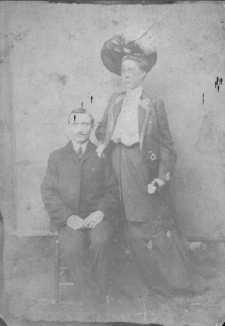Sign up for the Family Tree Newsletter Plus, you’ll receive our 10 Essential Genealogy Research Forms PDF as a special thank you!
Get Your Free Genealogy Forms
"*" indicates required fields

It’s hard to believe that a year has passed since this column debuted last February. Thank you for submitting your unidentified photographs. Every other week, I review the entire file of submissions and select one to feature in a column. Some of you are extremely patient, having waited months to see your photographic questions answered online. Please continue to send your photo mysteries! I love looking at them and find your questions challenging. Be sure to include your contact information with your photograph. I usually contact you prior to writing the column to ask a few additional questions. If I haven’t responded to your request, don’t despair. As you know from your own photo identification work, some images are less of a mystery than others. This week’s image was one of the first sent for identification.
Sandy Fine submitted this tintype a year ago, but assigning a date to the image was not straightforward. One of her cousins discovered this image in a relative’s photograph album. Sandy’s aunt remembers her father telling her that the picture was of Sandy’s great-grandparents. The aunt thought they were the maternal great grandparents until she compared this tintype to other photographs of those individuals. Now Sandy thinks the image is of her paternal great grandfather’s side of the family, the Liles.
This image was taken outside at an event or by an itinerant photographer in a temporary studio. Visible along the bottom of the image is the edge of the backdrop against the ground. Usually a photograph taken with the boundaries of the backdrop showing would be set into a paper mount to frame the image and eliminate any distractions. It was not possible to do it with this image because the gentleman is seated. In many portraits, it is the woman who sits in a chair and the man who stands next to her. However, this woman probably preferred to stand to show off her outfit. If she were seated, her hat would block the view of the gentleman’s head. Instead the gentlemen is facing the camera with his hands folded in his lap. The whole appearance of the image is unusual because the roles are reversed. She appears to be clasping a set of gloves in her left hand while her right rests protectively on the gentleman’s shoulder. It is also possible that this is a portrait of a brother and sister rather than a husband and wife. It is difficult to tell their ages due to the cloudiness of the image.
At first glance, this photograph seemed to be an easy photo identification until I tried to date the different pieces of the woman’s costume. There are several odd elements in her dress. While the jacket fits on her shoulders, her shirt and skirt appear to be oversized. While it was fashionable to wear full blouses overhanging the waistband of the skirt, the fullness combined with her unusual overskirt pleated down the center give the appearance of an outfit that doesn’t quite fit properly. The skirt is overly long for the period of the hat and jacket. It is possible that the outfit, with the exception of the hat, was handmade. Across the bottom of the skirt and on the sleeves and jacket front are a series of decorative patches, which have not been identified at this point.
I was puzzled about Sandy’s photo until I picked up a new book for my collection, Vintage Hats & Bonnets, 1770-1970 by Susan Langley (Collector Books, $24.95). In it, I came across an illustration from the cover of Collier’s Magazine from Oct. 15, 1904. The hat in the illustration is very similar to the one worn by the woman in this tintype. The large plumed hats that rested on the crown of a woman’s head required long hatpins to hold them in place. The illustration shows the Gibson Girl pinning her hat. The only difference is that the hat in the tintype also has a ribbon on the front of the upturned brim. Finally, I could place the photograph in a time frame.
The woman in this tintype is wearing a typical costume for the period 1904-1914. Her hat establishes a time frame for the photograph but the other unusual elements make it difficult to narrow down the time any further. The style of suit jacket with trimmed edges and high-necked blouse can be seen in this image, but her narrow sleeves suggest a time circa 1910. Unfortunately the fine details of the gentleman’s suit are not visible so those elements are not helpful in assigning a more specific year.
Many of you have submitted images similar to Sandy Fine’s tintype. Each one is missing small pieces of information that would help date the pictures. While I have covered the print-outs of these photographs with notes and page numbers of references, I have not been able to fully identify them yet. Since I regularly review your submissions, it is possible that the next photographic mystery solved in my column will be yours. Don’t give up hope—I don’t.
Thank you for reading this column!
Find out how to submit your own picture for possible analysis by Maureen Taylor. E-mail her at mtaylor@taylorandstrong.com.
ADVERTISEMENT

